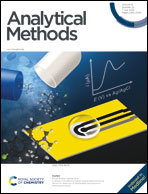Identification and semi-quantification of nitrooxy organosulfates in aerosol particles by HPLC-MS/MS
Abstract
Organosulfates (OSs) derived from the oxidation of biogenic volatile organic compounds (BVOCs) in the presence of anthropogenic sulfate aerosols are the important tracers of secondary organic aerosols (SOAs). In order to better understand the concentration of pinene-nitrooxy organosulfates (pNOSs) in Nanjing, a sensitive high-performance liquid chromatography-electron spray ionization spectrum/mass spectrum (HPLC-ESI-MS/MS) to determine pNOSs in PM2.5 has been developed and validated in this study. Firstly, Hypersil Gold C18 (Thermo Scientific, San Jose, USA) was selected to separate pinene-derived nitrooxy organosulfates (pNOSs) based on their polarity. Three kinds of pNOSs were detected in the full scan mode (MS) with an ESI source under the negative mode. Secondly, three isomers of pNOSs with fragment ions m/z 220, 151, and 142 were identified based on the MS/MS maps. At least two pairs of transfer ions should be selected as identification and quantification ions according to the optimization results of target compounds. For example, to determine pNOSs, these transfer ions of m/z 294 → 247, m/z 294 → 231, m/z 294 → 220, m/z 294 → 142, m/z 294 → 151, m/z 294 → 96, m/z 294 → 80 were selected as quantification and identification ions. Finally, the influence of scan mode on pNOS detection was evaluated, and the results showed that pNOSs were most sensitive in the SRM (selected reaction monitor) scan mode. Therefore, the SRM scan mode was chosen to detect pNOSs. We applied this method to analyze year-round PM2.5 (PM2.5 is fine particulate matter, which refers to particulate matter in ambient air with an aerodynamic equivalent diameter of less than or equal to 2.5 microns) samples in Nanjing. The average concentration of all the three kinds of pNOSs was 69.95 ng m−3. The results showed that the average concentration of pNOSs was high in spring (92.94 ng m−3) and summer (90.57 ng m−3), and lowest in winter (30.03 ng m−3).



 Please wait while we load your content...
Please wait while we load your content...